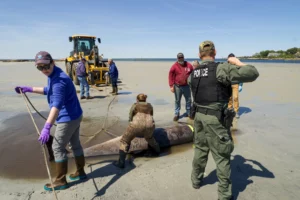A unique whale species washed up in New England, giving a rare glimpse of a deep sea diver

A rarely seen Sowerby’s beaked whale beached itself in Gloucester last week. (Brian Yurasits / Seacoast Science Center)
The calls started coming in around 9:30 a.m. last Thursday.
A funny looking whale, or maybe a dolphin, had washed ashore on Wingaersheek Beach in Gloucester, Mass. Brian Yurasits, part of the Marine Mammal Rescue team based at the Seacoast Science Center in Rye, was one of the first on the scene.
“It was alive when it initially stranded, and was noted to be somewhat lethargic, but still thrashing occasionally,” he said.
Yurasits had never seen this kind of whale before. Neither had anyone else from the response crew, which included teams from NOAA and the International Fund for Animal Welfare from Cape Cod.
It was a deep sea species called a Sowerby’s beaked whale: “Some of the deepest diving animals in the ocean,” Yurasits explained.
Silver, sleek and strong, this whale had beached itself on a shallow sand bar. It was a juvenile female, more than 13 feet long and weighed an estimated 1,700 pounds.
“These animals have a large melon on their head,” said Yurasits. “They have a very long beak and actually no teeth that are visible. So, almost similar to a mix between a whale and a dolphin.”
Though a few beaked whales have washed up on New England beaches before, this is a long way from their typical homes.
Sowerby’s are “cryptic” animals, according to Yurasits. Their normal habitat is in deep waters, making it tough for scientists to study them up close. They can dive for up to 28 minutes at a time before returning to the surface.

Marine mammal responders from across the region participated in the mission. (Brian Yurasits / Seacoast Science Center)
“They spend most of their time off of the continental shelf of the North Atlantic. So this animal was severely out of habitat,” he said. “You would never expect to see these things near shore, let alone in a few feet of water.”
Because of its location and the changing tides, the rescue team ruled out bringing in heavy equipment to move the animal. There were also concerns about refloating an animal so far from its normal range.
There didn’t appear to be any signs of human or boat interactions, or any significant wounds.
But around 1 p.m., researchers watched as the whale made final distress motions, and then died.
Afterwards a team from the University of New Hampshire performed a necropsy, with preliminary results showing some swelling in the brain. It could take at least a month, however, for tissue sample testing to provide more conclusive results.
The head of the animal was removed and will be sent to the Smithsonian Institution for its research collection. The body was buried at an undisclosed location, back on Wingaersheek Beach.
Yurasits said while rescuers are used to watching this process play out, it can be “truly difficult to see these sentient, amazing animals suffer.”
“These are charismatic megafauna,” he said. “Big animals that people care a lot about.”
This Sowerby’s beaked whale had its life cut short, but scientists will try to learn from its tissue samples to better understand how it lived.
